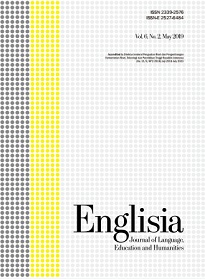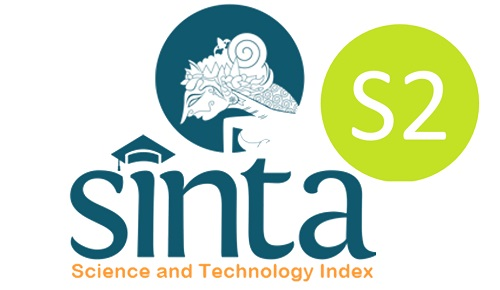Emergency remote teaching during COVID-19 crisis: An analysis of EFL students’ engagement in Aceh
DOI:
https://doi.org/10.22373/ej.v9i2.11722Keywords:
Emergency remote teaching, Behavioral engagement, Emotional engagement, Cognitive engagementAbstract
To prevent the spread of the coronavirus (Covid-19) and its pandemic, emergency remote teaching must be implemented. This has brought significant problems and difficulties for students due to this unusual circumstance, EFL students must learn to adapt their abilities. Because of the widespread use of technology in education, the quick transition to complete online learning necessitates some adjustment. EFL students must be able to handle online learning that is performed through technology integration and utilizing technological tools they have never used before in a short period of time. In response to emergency remote teaching, this study examined how engaged EFL students are, as well as their perceptions of such engagement. One hundred ninety-one students from four state Islamic universities in Aceh filled out an online questionnaire adapted from McColskey (2012). Both descriptive and thematic methods were used to analyze the data. EFL students demonstrated their level of engagement in all three categories of engagement: behavioral, emotional, and cognitive engagement. Positive responses and feelings of satisfaction were shown during emergency remote teaching. It indicates that EFL students have a better grasp of how to use technology in education. It is essential to constantly enhance their skills and have enough equipment and infrastructure to facilitate online learning.
Downloads
References
Abou-Khalil, V., Helou, S., Khalifé, E., Chen, M. A., Majumdar, R., & Ogata, H. (2021). Emergency online learning in low-resource settings: Effective student engagement strategies. Education Sciences, 11(1), 1–18. https://doi.org/10.3390/educsci11010024
Ahmadi, D. M. R. (2018). The Use of Technology in English Language Learning: A Literature Review. International Journal of Research in English Education, 3(2), 115–125. https://doi.org/10.29252/ijree.3.2.115
Alrashidi, O., Phan, H. P., & Ngu, B. H. (2016). Academic Engagement: An Overview of Its Definitions, Dimensions, and Major Conceptualisations. International Education Studies, 9(12), 41. https://doi.org/10.5539/ies.v9n12p41
Anderson, E. (2017). Measurement of Online Student Engagement: Utilization of Continuous Online Student Behavior Indicators as Items in a Partial Credit Rasch Model. ProQuest LLC, 1–254.
Ansong, D., Okumu, M., Bowen, G. L., Walker, A. M., & Eisensmith, S. R. (2017). The role of parent, classmate, and teacher support in student engagement: Evidence from Ghana. International Journal of Educational Development, 54(March), 51–58. https://doi.org/10.1016/j.ijedudev.2017.03.010
Atmojo, A. E. P. (2021). EFL teachers’ online teacher professional development experiences amidst the COVID-19 pandemic: Practices and perceptions. Englisia: Journal of Language, Education, and Humanities, 9(1), 1. https://doi.org/10.22373/ej.v9i1.9127
Baloran, E. T., Hernan, J. T., & Taoy, J. S. (2021). Course Satisfaction and Student Engagement in Online Learning Amid Covid-19 Pandemic: a Structural Equation Model. Turkish Online Journal of Distance Education, 22(4), 1–12. https://doi.org/10.17718/tojde.1002721
Bao, W. (2020). COVID ‐19 and online teaching in higher education: A case study of Peking University . Human Behavior and Emerging Technologies, 2(2), 113–115. https://doi.org/10.1002/hbe2.191
Becta. (2004). A REVIEW OF THE RESEARCH LITERATURE ON BARRIERS TO THE UPTAKE OF ICT BY TEACHERS. Journal of Physics: Conference Series, 842(1), 1–29. https://doi.org/10.1088/1742-6596/842/1/012074
Bergdahl, N., Nouri, J., Fors, U., & Knutsson, O. (2020). Engagement, disengagement and performance when learning with technologies in upper secondary school. Computers and Education, 149, 103783. https://doi.org/10.1016/j.compedu.2019.103783
Bond, M. (2020). Facilitating student engagement through the flipped learning approach in K-12: A systematic review. Computers and Education, 151(October 2019), 103819. https://doi.org/10.1016/j.compedu.2020.103819
Bozkurt, A., & Sharma, R. (2020). Emergency remote teaching in a time of global crisis due to CoronaVirus pandemic. Asian Journal of Distance Education, 15(1). https://doi.org/10.5281/zenodo.3778083
Cloete, A. L. (2017). Technology and education: Challenges and opportunities. HTS Teologiese Studies / Theological Studies, 73(4). https://doi.org/10.4102/hts.v73i4.4589
Creswell, J. W. (2012). Educational Research: Planning, Conducting and Evaluating Quiantitative and Qualitative Research (4th Editio). United State of America: Pearson.
Deschaine, M. E., & Whale, D. E. (2017). Increasing Student Engagement in Online. Journal of Educators Online, 14(1), 113–120. Retrieved from https://eric.ed.gov/?id=EJ1133612
Dhawan, S. (2020). Online Learning: A Panacea in the Time of COVID-19 Crisis. Journal of Educational Technology Systems, 49(1), 5–22. https://doi.org/10.1177/0047239520934018
Duffy, G., & Elwood, J. (2013). The perspectives of “disengaged” students in the 14-19 phase on motivations and barriers to learning within the contexts of institutions and classrooms. London Review of Education, 11(2), 112–126. https://doi.org/10.1080/14748460.2013.799808
Dwi Sloria Suharti, Didi Suherdi, S. S. (2021). Exploring Students’ Learning Engagement in EFL Online Classroom. Proceedings of the Thirteenth Conference on Applied Linguistics (CONAPLIN 2020), 546(Conaplin 2020), 139–149. https://doi.org/10.2991/assehr.k.210427.022
Francom, G. M. (2020). Barriers to technology integration: A time-series survey study. Journal of Research on Technology in Education, 52(1), 1–16. https://doi.org/10.1080/15391523.2019.1679055
Fraysier, K., Reschly, A., & Appleton, J. (2020). Predicting Postsecondary Enrollment With Secondary Student Engagement Data. Journal of Psychoeducational Assessment, 38(7), 882–899. https://doi.org/10.1177/0734282920903168
Goldspink, C., Winter, P., & Foster, M. (2008). Student Engagement and Quality Pedagogy. European Conference on Educational Research in Goteborg, 1–19. Retrieved from http://www.earlyyears.sa.edu.au/files/links/student_engagement_and_qua.pdf
Harunasari, S. Y., & Halim, N. (2019). Digital backchannel: Promoting students’ engagement in EFL large class. International Journal of Emerging Technologies in Learning, 14(7), 163–178. https://doi.org/10.3991/ijet.v14i07.9128
Hodges, C., Moore, S., Lockee, B., Trust, T., & Bond, A. (2020). The Difference Between Emergency Remote Teaching and Online Learning. Educause Review, 7.
Jelińska, M., & Paradowski, M. B. (2021). Teachers’ engagement in and coping with emergency remote instruction during covid-19-induced school closures: A multinational contextual perspective. Online Learning Journal, 25(1), 303–328. https://doi.org/10.24059/olj.v25i1.2492
Khlaif, Z. N., Salha, S., & Kouraichi, B. (2021). Emergency remote learning during COVID-19 crisis: Students’ engagement. Education and Information Technologies, (0123456789). https://doi.org/10.1007/s10639-021-10566-4
Liang, R., & Chen, D.-T. V. (2012). Online Learning: Trends, Potential and Challenges. Creative Education, 03(08), 1332–1335. https://doi.org/10.4236/ce.2012.38195
Martin, F., & Bolliger, D. U. (2018). Engagement matters: Student perceptions on the importance of engagement strategies in the online learning environment. Online Learning Journal, 22(1), 205–222. https://doi.org/10.24059/olj.v22i1.1092
Martin, J., & Torres, A. (2012). What is student engagement and why is it important? National Association of Independent Schools, 8, 22–26. Retrieved from http://www.mpict.org/ict_education_defined_importance.html
McColskey, J. A. F. and W. (2012). Handbook of Research on Student Engagement. Handbook of Research on Student Engagement, 1–840. https://doi.org/10.1007/978-1-4614-2018-7
Miles, M. B. A. M. and H. (2014). An analytic approach for discovery. In CEUR Workshop Proceedings (Vol. 1304). London: SAGE Publications.
Oraif, I., & Elyas, T. (2021). The impact of COVID-19 on learning: Investigating EFL learners’ engagement in online courses in Saudi Arabia. Education Sciences, 11(3), 1–19. https://doi.org/10.3390/educsci11030099
Pan, Z., David Cheok, A., Mueller, W., & Zhang, M. (2015). Transactions on edutainment XI. In Transactions on Edutainment XI. https://doi.org/10.1007/978-3-662-48247-6
Perets, E. A., Chabeda, D., Gong, A. Z., Huang, X., Fung, T. S., Ng, K. Y., … Yan, E. C. Y. (2020). Impact of the emergency transition to remote teaching on student engagement in a non-stem undergraduate chemistry course in the time of covid-19. Journal of Chemical Education, 97(9), 2439–2447. https://doi.org/10.1021/acs.jchemed.0c00879
Rayuwati, R. (2020). How educational technology innovates distance learning during pandemic crisis in remote areas in Indonesia? International Research Journal of Management, IT and Social Sciences, 7(6), 161–166. https://doi.org/10.21744/irjmis.v7n6.1032
Schutte, P. (2021). Emergency remote teaching: Students’ experiences during the covid-19 lockdown. Diurnalis Socialibus Scientiis, 23(2), 121–135.
Senior, R. M., Bartholomew, P., Soor, A., Shepperd, D., Bartholomew, N., & Senior, C. (2018). “The Rules of Engagement”: Student Engagement and Motivation to Improve the Quality of Undergraduate Learning. Frontiers in Education, 3(May), 1–9. https://doi.org/10.3389/feduc.2018.00032
Shim, T. E., & Lee, S. Y. (2020). College students’ experience of emergency remote teaching due to COVID-19. Children and Youth Services Review, 119(October), 105578. https://doi.org/10.1016/j.childyouth.2020.105578
Sintema, E. J. (2020). Effect of COVID-19 on the performance of grade 12 students: Implications for STEM education. Eurasia Journal of Mathematics, Science and Technology Education, 16(7), 1–6. https://doi.org/10.29333/EJMSTE/7893
Tao, Z., Zhang, B., Ka, I., & Lai, W. (2018). and Students ’ Learning Performance in Higher Education : Mediating Role. Springer Singapore. https://doi.org/10.1007/978-981-13-0008-0
Toquero, C. M. (2020). Emergency remote teaching amid COVID-19: The turning point. Asian Journal of Distance Education, 15(1), 185–188. Retrieved from http://www.asianjde.org/ojs/index.php/AsianJDE/article/view/450
Virtanen, T. E., Lerkkanen, M. K., Poikkeus, A. M., & Kuorelahti, M. (2015). The relationship between classroom quality and students’ engagement in secondary school. Educational Psychology, 35(8), 963–983. https://doi.org/10.1080/01443410.2013.822961
Wong, A., & Chong, S. (2018). Modelling adult learners’ online engagement behaviour: proxy measures and its application. Journal of Computers in Education, 5(4), 463–479. https://doi.org/10.1007/s40692-018-0123-z
Xu, Y., Jin, L., Deifell, E., & Angus, K. (2021). Chinese character instruction online: A technology acceptance perspective in emergency remote teaching. System, 100. https://doi.org/10.1016/j.system.2021.102542
Zimmer, J. D. F. and K. S. (2012). Handbook of Research on Student Engagement. In Handbook of Research on Student Engagement. https://doi.org/10.1007/978-1-4614-2018-7
Downloads
Published
Issue
Section
License
Proposed Policy for Journals That Offer Open Access
Authors who publish with Englisia journal agree to the following terms:
- Authors retain copyright and grant the journal right of first publication with the work simultaneously licensed under a Creative Commons Attribution License that allows others to share the work with an acknowledgement of the work's authorship and initial publication in this journal.
- Authors are able to enter into separate, additional contractual arrangements for the non-exclusive distribution of the journal's published version of the work (e.g., post it to an institutional repository or publish it in a book), with an acknowledgement of its initial publication in this journal.
- Authors are permitted and encouraged to post their work online (e.g., in institutional repositories or on their website) prior to and during the submission process, as it can lead to productive exchanges, as well as earlier and greater citation of published work (See The Effect of Open Access).









